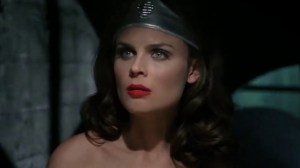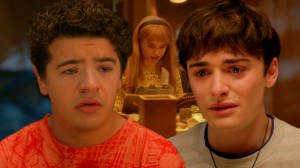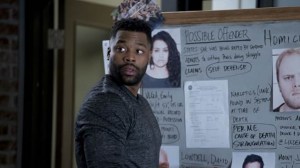One of the year’s most thrilling and mysterious films is Osgood Perkins’ horror experience Longlegs, whose marketing campaign managed to merely tease the terror contained in the picture without fully revealing what was in store for audiences. With the film itself being crafted outside the realm of marketing campaigns, editors Greg Ng and Graham Fortin had a slightly different approach to realizing Perkins’ vision, though the storytellers did all approach the frightening feature with the precision of wanting to only offer audiences as clear of looks at the titular killer as they wanted. Longlegs is out now in theaters.
Videos by ComicBook.com
Longlegs is described, “FBI Agent Lee Harker (Maika Monroe) is a gifted new recruit assigned to the unsolved case of an elusive serial killer (Nicolas Cage). As the case takes complex turns, unearthing evidence of the occult, Harker discovers a personal connection to the merciless killer and must race against time to stop him before he claims the lives of another innocent family.”
ComicBook caught up with Ng and Fortin to talk about realizing Perkins’ vision, cutting together footage of Cage’s killer, and more.
WARNING: Minor spoilers below for Longlegs

ComicBook: Is there much footage or many scenes of Longlegs that didn’t make it into the final cut because maybe they were showing too much of his background and maybe ruining that mystery, or even just hours and hours of Nick Cage being incredible and frightening as Longlegs?
Graham Fortin: That’s interesting. There is a lot of material from the jail scene or the interrogation room scene. I remember, can we say “Crimson and Clover?” Cage sang that whole entire song, like, “Crimson and Clover. Over and over…” And that was in for a while, and then we lost that. There’s some material from the house I remember that was lost.
Greg Ng: I do feel like they’re fairly efficient with all that. While the scenes were maybe trimmed, there weren’t tons of scenes that were lying on the cutting room floor. There was certainly extra material, and it’s Nick Cage, so everything was gold. It wasn’t a matter of we didn’t want to use it, it was just that there’s so much of it, and you can only give the audience … You’ve got to give everybody what they need instead of, you can’t just give them a Nick Cage milkshake and throw it in everyone’s face. So maybe people would like that, but that’s not what this movie is.
Fortin: Cage has also said in other interviews, he’s like, “Oh, it’s like he’s a shark. You don’t want to see too much.” It’s like Jaws, and if you see too much of Longlegs, then the terror of him goes away.
A two-part question is, what was the most fun scene to cut and then what was the most challenging scene to cut?
Fortin: The most fun, I think the interrogation room scene was a lot of fun because that’s just so intense and it’s like, “Here we go,” and it’s Cage. And we’re lucky enough to be able to touch that footage and just look at it, all the raw stuff. A dream.
Ng: I would say that the most fun scenes are the ones that elicit the strongest reaction because they pay off so well, when you’re sitting in a theater and people scream or laugh or whatever.
One of my favorite scenes is when Lee’s at the house and she gets a “present,” we played around with the tension, because everyone … we knew that people were on board and the tensions are high and the house is creaky. “What’s going on? Is something going to happen?” Something’s going to happen. And there’s a fake little pop when she slams her hand on the desk, which was totally unnecessary, but it was a fun thing to play with because everyone’s like, “Oh, yeah, it’s nothing, goddammit.” And there’s a time and place for a cheap scare, and that was the one there. I always have fun with that moment.
I think the most challenging part of the movie is the ending, because we are trying to climax the backstory of everything with what’s happening in the present and how much we can weave back Longlegs into all these things that are happening while filling in all the gaps and still at the same time not give too much information.
So at the end, we get the story of the mom and we get the story of what Longlegs is really doing, but that was a hard one to get to. I feel like it is also a strange … maybe a place for something that feels like, when I think of those moments after Lee comes to the house and finds her mom, I think of the prologue for The Lord of the Rings, very different, but there’s narration and story time. But there’s a lot of times you get these moments of storytelling with narration at the beginning of the movie, not so much at the climax of the movie. I found that that was a very challenging section, but I think it’s very rewarding for that to come together.
Fortin: Beginnings and endings are always hard.
Is there a specific thing that you suggested to Oz or experimented with for Oz that he was like, “Oh, you really cracked the code,” you brought something to the table that he didn’t necessarily see at first glance that you were able to bring into the finished film?
Ng: There’s so many things that happen within the edit suite that are some of the best things. For example, we always talk about we’re hitting a wall. “I have no idea what we’re doing here. Is this movie even working? I’m going to go to the bathroom.” And going to the bathroom was this strange cave of inspiration that someone would go to the bathroom, come back, and be like, “Ha, you know what would be funny, is if there was demons everywhere or whatever, and then…” “Wait a second. Wait, what does that mean…” So sometimes some of these jokey bathroom inspirations would then become ideas that we would implement into the film, and some of them are there.
It’s hard to, say, claim ownership over so many things, but certainly, we contributed some fun ideas throughout the process. It’s inevitable, you’re just hanging out spitballing and something’s going to stick. But if I was to pick, one of my favorite things is when Harker’s mom comes up behind the car, that was an editorial discovery or way to convey that. And that’s one of the biggest pops I think in the movie, if you know what I’m talking about.
Fortin: Well, I think like Greg was saying, it’s this zone of contribution from everyone. Again, filmmaking is a team effort and all of these different departments coming together, they all feed off of each other. Everyone’s ideas feed off of each other, and seeing the unfinished film versus the finished film with an audience is wildly different. I had some friends in the test screening and some ideas in the sound department. Once those were completed, that gives everything a whole different experience in the theater. I remember at some point bringing in or getting all of the art department’s raw files and we scan the ciphers and all of the police crime scene photos.
Ng: Death certificates, and that sort of thing.
Fortin: Death certificates, and we got that from Brendan Meganetty, he was responsible for a lot of that material. Danny Vermette’s production design also creates the whole atmosphere of the film. But anyway, pulling those elements together, we had the post team scan everything and Oz went through, it was almost like he was Lee Harker where we pulled out the crime scene investigation box and we brought it to the suite and we were just putting things on the floor, and it’s like, “Which one’s good? Which one’s bad? Okay, let’s put it all together, scan it,” and then those elements were into the film, and that was fun.
Ng: That’s a big part of the movie is all that stuff and the supplementary, what do you call that stuff? The microfiche machine.
It’s almost more like a mixed media project than necessarily a linear film where it’s moving footage that you’re incorporating. No, here’s a photo, here’s whole different aspect ratio. Here’s the microfiche.
Fortin: The phone calls.
Ng: All the phone calls were pretty fun, because they also did a second unit thing where they shot all the imagery, like snakes and all that good stuff, and milk and blood, and it just adds a lot of texture to the movie. It’s like, “Well, where can we stick this? This is going to be great.”
Fortin: That was fun going through with it Oz, too, because we go through every frame of that and he is like, “No, no, no.” That was one of the first things we did, actually. He’s like, “Let’s start with the snakes. Let’s do a snake pass.” And we’re going through bad snake, good snake. “Ah, this is bad, isn’t it? No, no, no. Flip it. Turn it.” That was fun.
You both mentioned earlier that you’ve still been talking with Oz. Do you have anything on the horizon planned with Oz of what you might tackle next?
Fortin: Well, there’s two projects coming. One’s Stephen King’s The Monkey, and then the other project is called Keeper. That is what’s bubbling around.
Ng: We’re currently working on both of those, and they have been pretty exciting. We can’t really talk much about them other than to say we’re having a good time working on them.
Fortin: And Neon is evolved in those two, which is exciting. So there’s information out there, but it’s all been approved information.
Longlegs is in theaters now.
This interview has been edited for length and clarity. You can contact Patrick Cavanaugh directly on Twitter.








